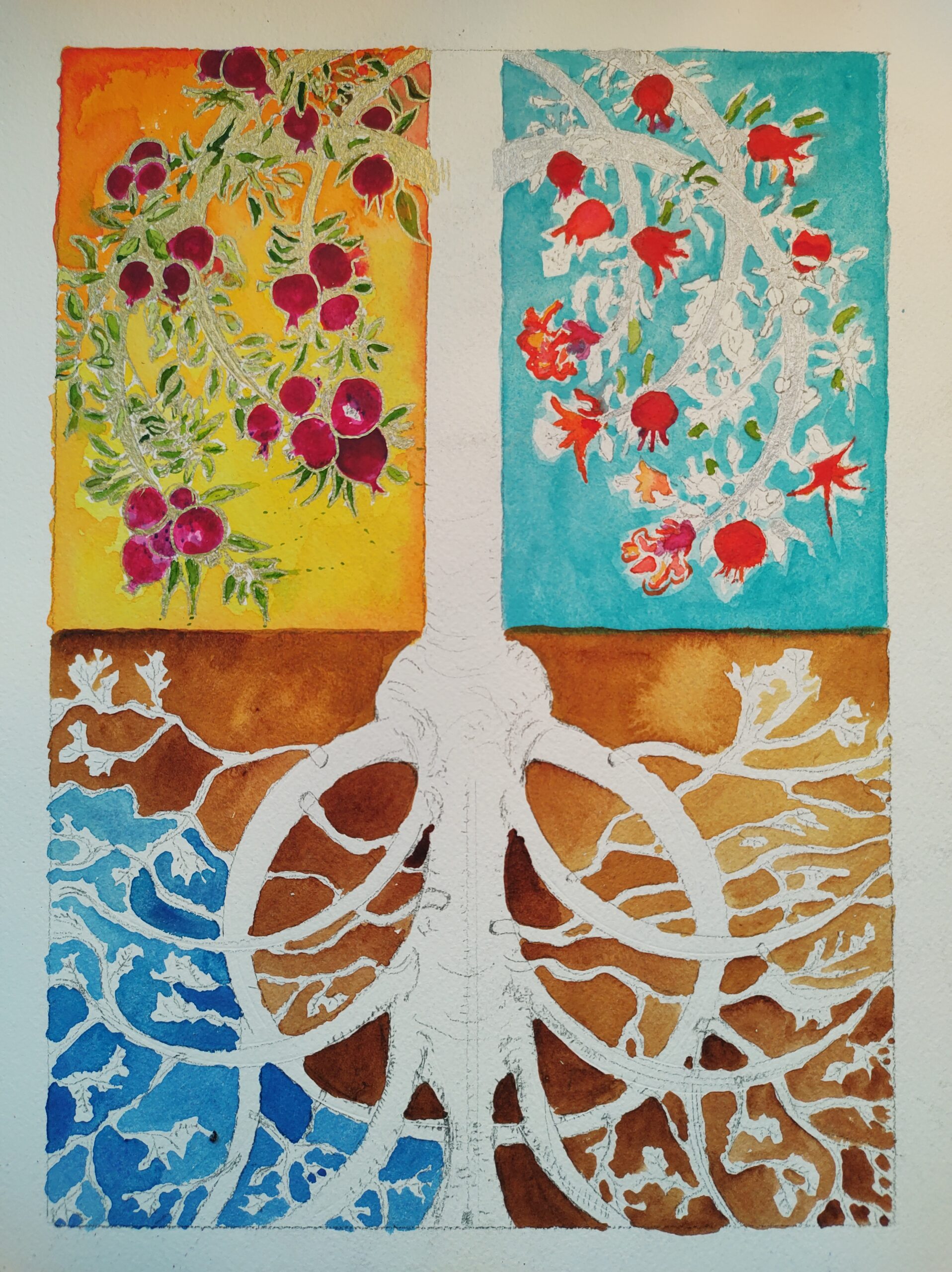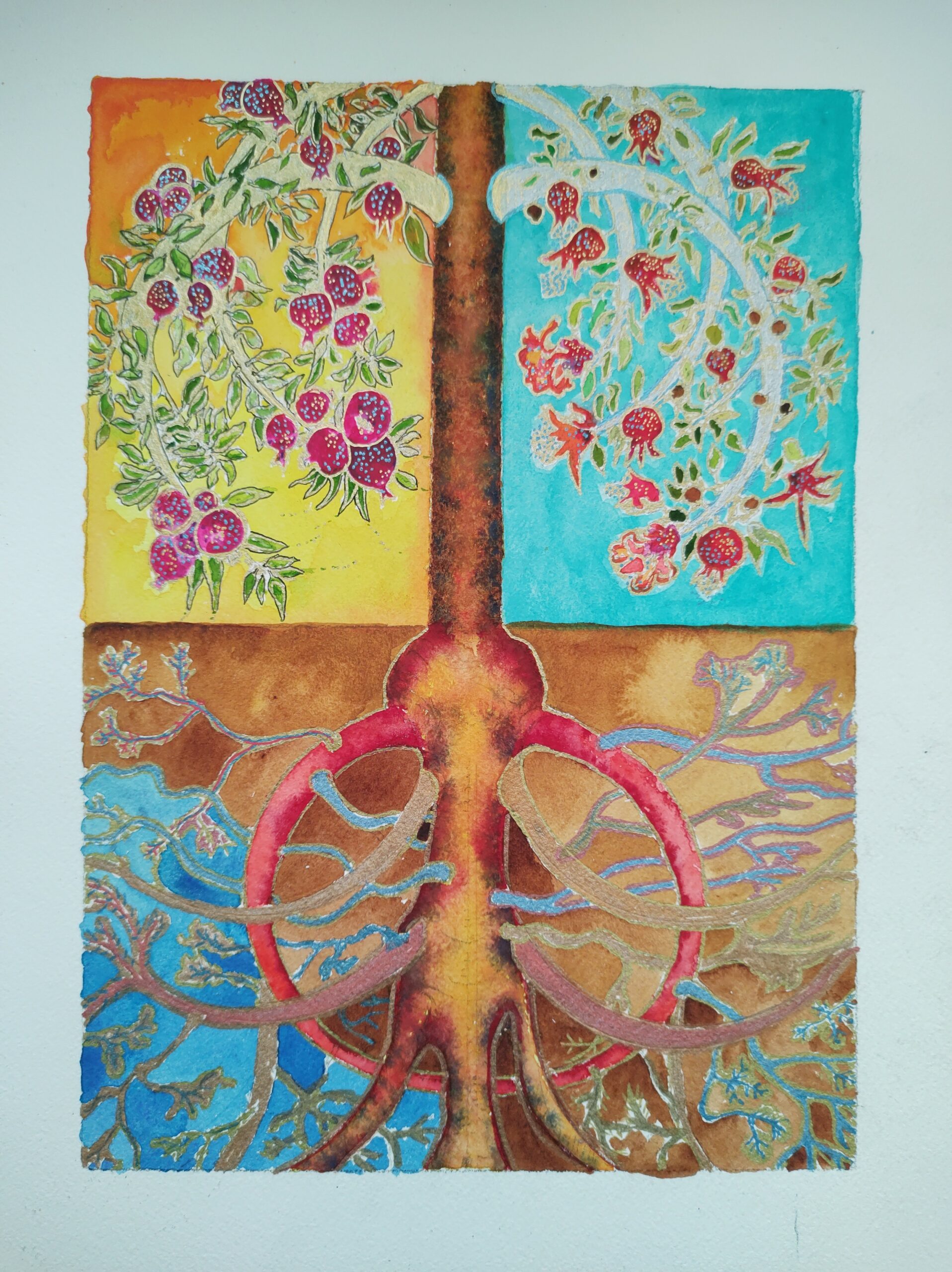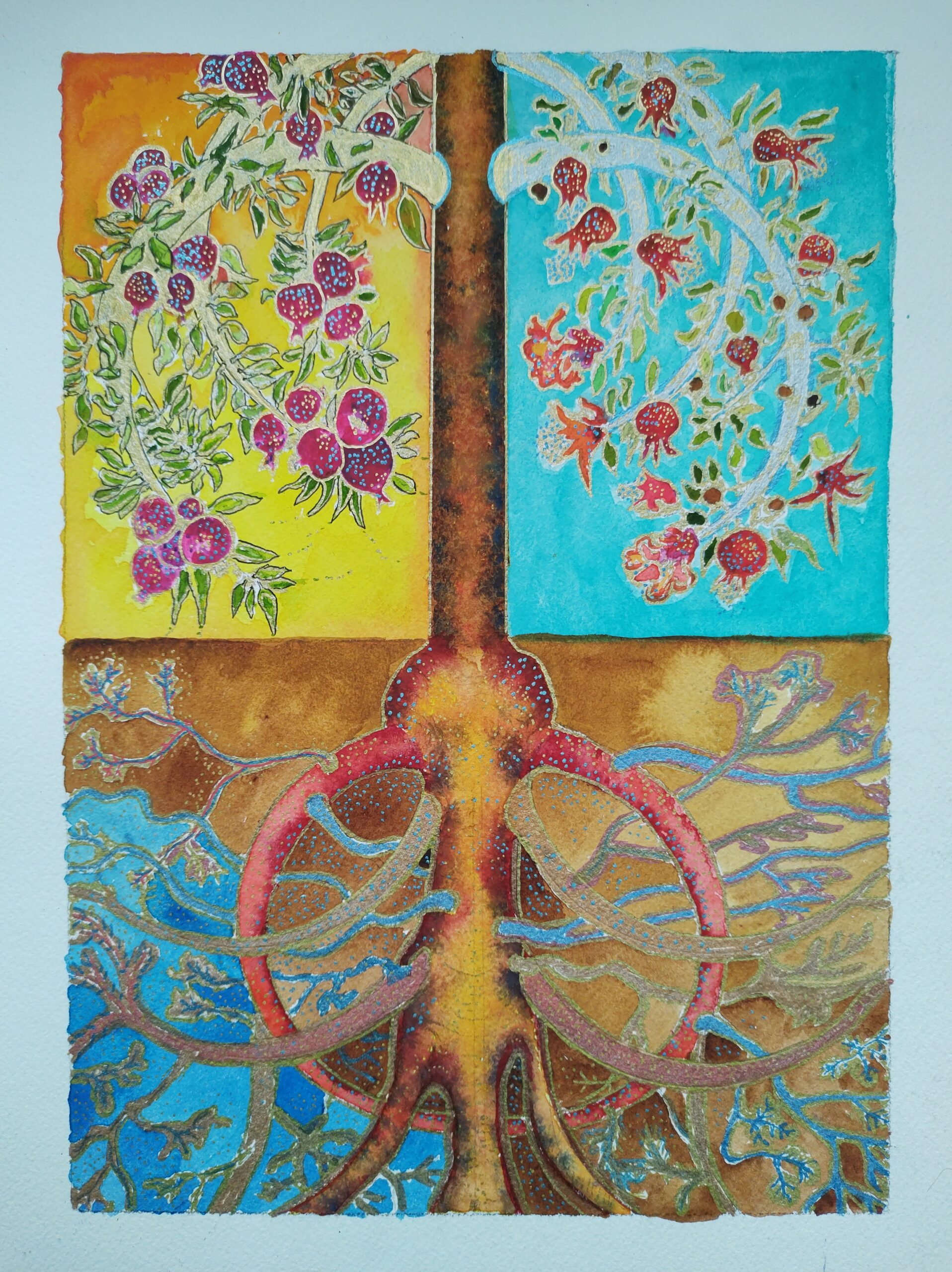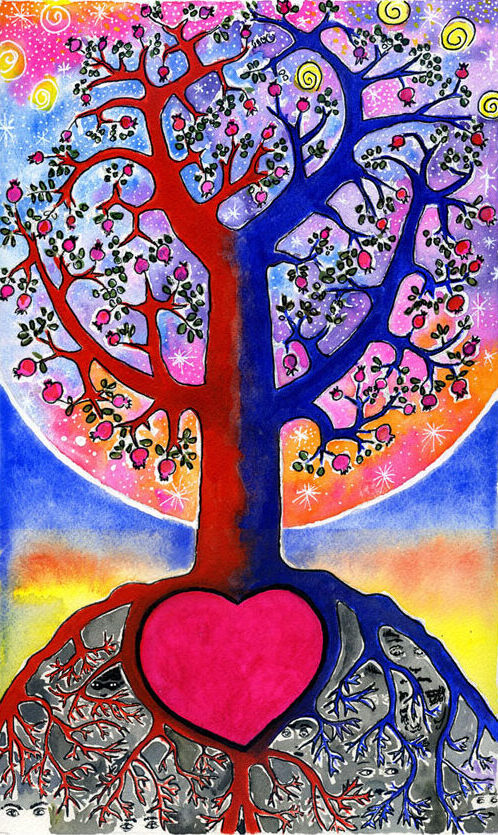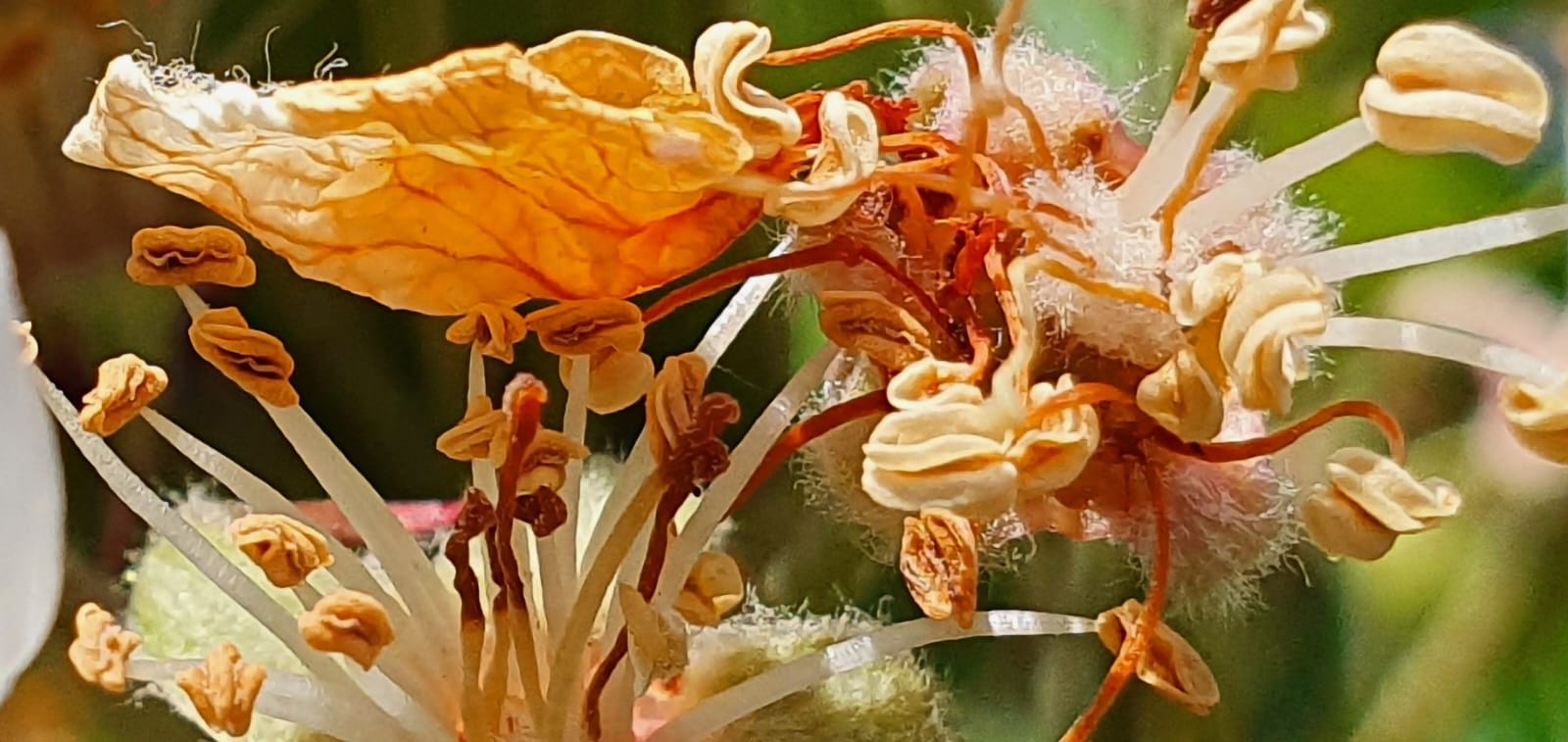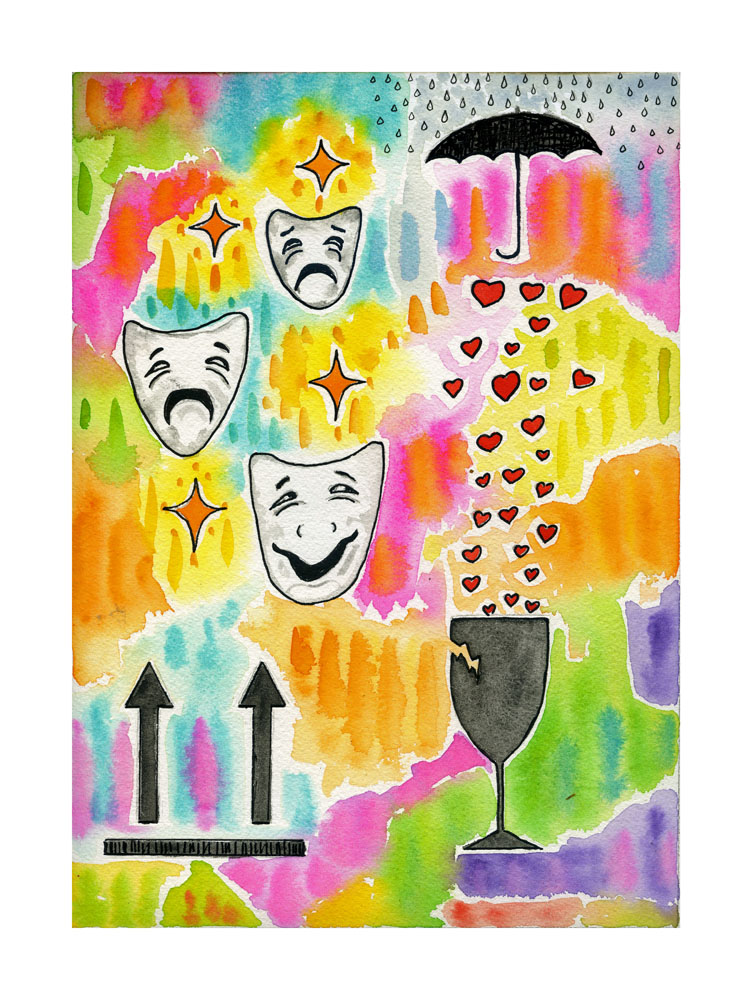Auteurs: Greg Suffanti, Robin Stemerding en Heidi Muijen
Een bijzondere ontmoeting
Een bijzondere ervaring: hoe de ontmoeting van mensen, die elkaar (deels) voor het eerst zagen op de startbijeenkomst op 30 maart 2024 in Weesp, tot zulke sterke positieve energie heeft geleid! Deze vormde een bedding naar de volgende bijeenkomst op 1 juni met het verklanken van werelddromen onder leiding van Marianne Selleger. Tussen beide bijeenkomsten in heeft dit proces tot een serie aquarellen van Greg Suffanti geleid, die de cocreatieve energie verbeeldt; met als doel vruchtbare gronding te geven aan het ‘spiraliseren en crealiseren’ rond een met klei in beelden vormgegeven Kosmisch Ei, om wat we als groep creëren, verder te dragen naar het afrondende interculturele evenement najaar 2024!
Opmerkelijk is dat Gregs eerste serie, die uitdrukking geeft aan de positieve kant van het proces als hartskracht van blijdschap en engagement, in de uitwisseling tussen Greg, Heidi en Robin naar een schaduwzijde voerde, die mede aanleiding vormde voor het initiëren van het project “Wereldburgerschap van de straat”: de bloedige geschiedenis van kolonisering en slavernij, die als onderstroom voelbaar is en terecht aan de kaak wordt gesteld als institutioneel racisme. Wij willen oog houden voor die ontmenselijkende kant van de migratie politiek en hoe dit in de sociale context en in onszelf doorwerkt, én juist ook positieve impulsen spiraliserend naar boven halen met onze werelddromen en die van migranten. De uitwisseling werkte zo aanstekelijk dat ook Robin rond het thema ging schilderen.
Dehumaniserende systemen
Greg: “‘Thy kingdom come, thy will be done, on earth as it is heaven.’ The Our Father prayer I grew up reciting before I went to sleep. I always believed it meant that whatever I had sown was what I would reap in heaven. Which actually is one of the reasons becoming a Buddhist was logical: I’ve always believed in cause and effect/result. I read an article about police in Britain arresting migrants with the intention of shipping them off to Rwanda. How does this cruel development relate to Kepler ’s Harmony of Spheres I asked myself? As a Buddhist I started thinking about the karmic energies at play and how this energy was like Kepler’s silent symphony of music between the planets and stars. Tory Party Harmony of Dreams was the result, which is my interpretation of this whole process. The right third of the composition features pink spheres flowing downward at the top. From the bottom, pink spheres flow upward. The movement is to suggest a circular flow, or the cycle of life. In the center are three gold balls flowing upward against a sky blue background. The gold balls symbolize the movement of the migrants flowing easily between their various rebirths.”
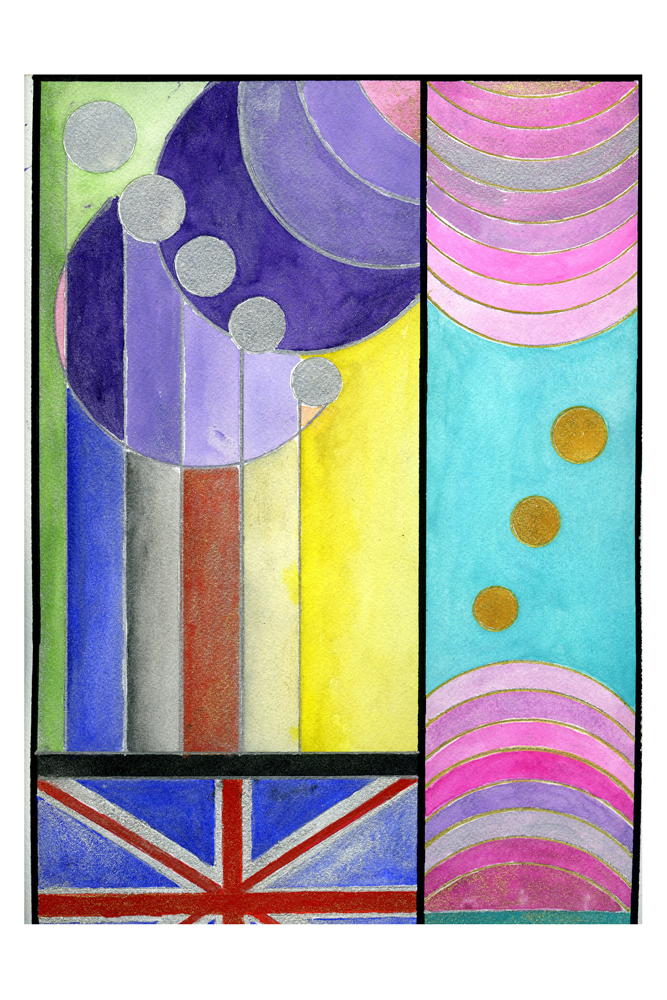
Aquarel Greg Suffanti
Robin: “Instead of pointing fingers, you make an aquarelle of Britain and the Rwanda ‘solution’. You try to point out that this blinded approach stays in its own Karmic perspective. As long as it is a solution for a few, and not a solution for everyone, it does not liberate or provide a way out of a vicious circle. I am puzzled by the right side of the aquarelle which looks amazingly light and relaxed. Does it portray life not only from a ‘lived time’ but also from a perspective of many lives again and again?”
Greg: “From the Buddhist perspective, looking for a better life, especially to help family, is not only logical, but has the potential to create powerful positive karmic energies which result in fortunate rebirths. Their earthly life is a similar sort of floating, except their lives are reduced to dreams and their waking reality is one of fear and being stateless. The left two thirds of the composition are a different story. The pink, heavenly spheres descending downward are mostly purple. This suggests the attitudes regarding migrants is out of heavenly balance. There’s a small hint of pink at the extreme left, suggesting hope for a change of attitude and policy…. And hope for a change of heart. We need to see migrants as worthwhile human beings.
Five descending silver balls represent the ruling Tory party. A vertical line on the left side of each ball descends downward, anchored to a thick black line, below which is the British flag. This construction symbolizes the reality of conservative nationalism. Given that a few senior ministers have been so outspoken about this Rwanda policy, and the government superseded the courts to reach its goal, the karmic implications are not only negative, they are blinded by their ideas to the point that they are outside of the heavenly flow. Although the Tories may achieve their goal, from the Buddhist perspective they may ultimately be achieving the exact opposite of what they truly want: In karmic terms the result is always similar to the cause. What might a karmic result be if one denies another a home?…”
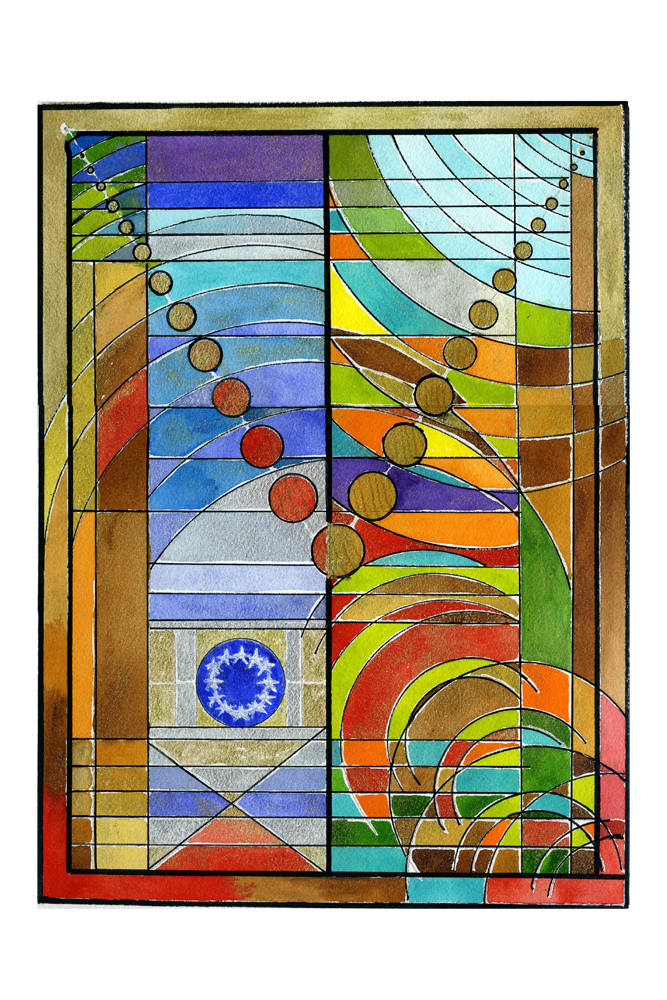
Aquarel Greg Suffanti
Greg: “I continued this idea about a karmic symphony in EU Migrant Harmony of Dreams. Here, the flag of the European Union sits in a gold box near the bottom left of the composition. To the top and bottom of the gold box are predominantly blue horizontal bars, which are part of a larger series of spheres. The blue symbolizes the 27 nations of the EU. A series of gold balls descends downward and upward, forming a ‘V’ shape in the top two thirds of the composition. The gold balls symbolize the plight of the migrant, coming from a heavenly realm, their plight here on earth and their return to a heavenly realm. Some of the gold balls become red in the ‘EU zone’. The choice of red symbolizes the blood of the migrant. The further use of red in the composition symbolizes the reality that in the history of Europe, it was the African who paid with their blood. Notice also that the entire composition is framed with the same African colors that dominate the entire composition. This isn’t about making a moral judgement, it’s about seeing the realities of how the two continents are historically intertwined and how the process of (de)colonization is playing out in the 21st century.”
Confrontatie met de schaduwkant
Robin: “The next aquarelle – the one with the flag of the European Union – urges me to look for an underlying truth that might help us understand what’s going on. It seems to ‘contain’ the need to see and recognize history from another perspective. Especially to find a way to accept cruelty and bloodshed. Instead of seeing Europe as a stainless, peaceful utopia, we’re now confronted with other truths that disturb this former ideal. What shall we wake up to? And what truth explains what makes new sense?
It reminds me of a Syrian and Palestinian poet and refugee living in Sweden that I saw on Youtube; and that blew my mind (see here and here).
The poem he read was shocking – as was the poem of the Dutch female poet in the same program. The disruption of a quiet experience and an undisturbed smooth reality, gives cracks in my Egg. A description of a shocking human situation which drives people to escape their homes and become refugees. Are we able to sympathize with others in this situation? Are we able to relate?”
The poet describes a way of collective forgetting, not consciously knowing and staying silent as a way to react to our painful parts of history.”
Heidi: “Dank Robin voor je respons op Greg en het delen van de indringende video beelden via de links: ik stap weer over op het Nederlands, omdat het ongemak en zijn diep doorleefde waarheid waarmee de Syrische gevluchte dichter Ghayath Almadhoun ons confronteert met zijn gedichten en in de interviews onuitsprekelijk zijn…. voor mij al helemaal niet in het Engels en eigenlijk ook niet in het Nederlands… ze zijn ‘beyond words’…!”
Greg: “I love your comment from the poet about hiding from ourselves Robin …… Why? Because it’s so fucking painful…. To look honestly at the world or ourselves is work and it is painful.
You mentioned going back and forth…. Me too! That self portrait as well as the aquarelle about Sergio’s 10 years in Amsterdam were surprisingly difficult to do…. I relived some of the most painful memories I’ve ever had. In fact, I’m about to start the next aquarelle after not painting for 5 days. I felt physically sick from the whole experience. I had a similar feeling after I wrote about these years for the QFWF…. That was several years ago and I’ve not written a word more. It left that bitter a taste in my mouth.
By the way… In the Rwanda aquarelle, the right side are the migrants going easily between the realms of heaven and earth. I was looking from the Buddhist perspective of rebirths. The full title is Tory Harmony of Spheres – Thy Kingdom Come. As in the prayer, “Thy kingdom come, thy will be done, on earth as in heaven”… Or, what goes around comes around. These Tories are creating the causes to be reborn homeless in future lives. In other words, they are creating the causes for their own misery.”
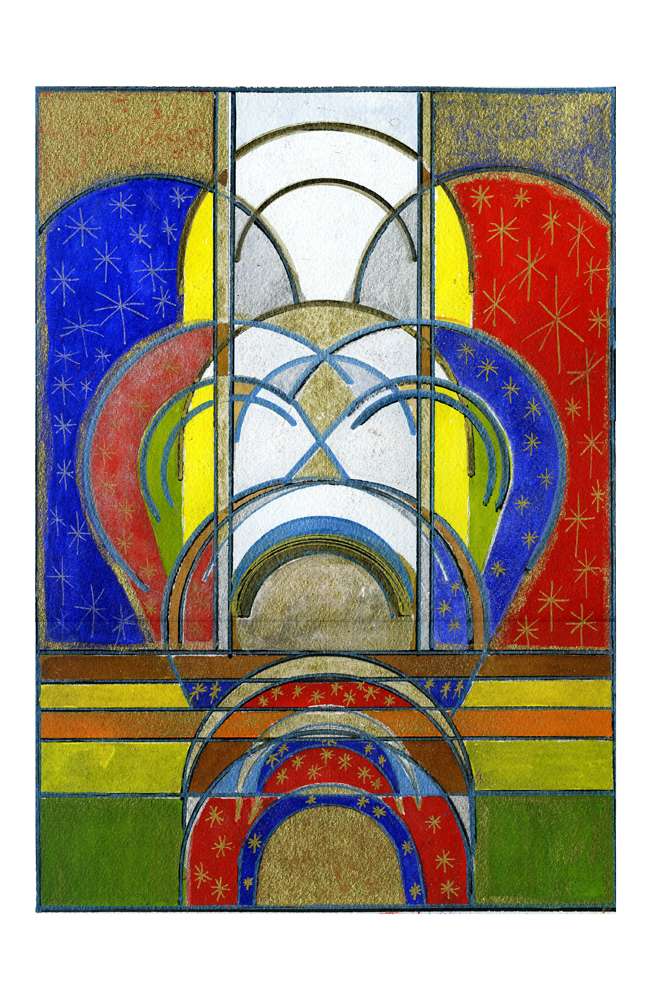
Aquarel Greg Suffanti
Greg: “Migrant American Harmony of Dreams’ development was based on my own experience of living in America for 35 years, of coming from parents who were first generation Americans and my own experience with being a…… migrant, dare I use the word? What’s the difference? I was a white man with money.
The composition is a bit tree shaped, although, my idea is really about a fountain. At the base, spheres descend upward. The green bar at the bottom symbolizes earth. The other bars on the bottom third of the composition symbolize the various countries most South American migrants must walk through on their way to trying to live out their own American dream. The red and blue spheres in the base contain stars, which are the dreams of migrants. The spheres expand upward and outward, no more horizontal bars… They’ve reached America. Millions of immigrants take this path, and millions of these people have and will become Americans.
I lived in Los Angeles for five years and know that such cities also protect the millions of illegal migrants who will also call America ‘Home’. Most of the migrants have family in America, and most of them immediately begin to work, becoming valuable members of society. In America, these are the people who look after your children if you work, do your yard work, cook your food in restaurants and harvest it from the fields. In that sense, the system is very different from the EU, where cumbersome rules keep people from working for years. The stars become part of the red (white) and blue stripes which is the migrant living their own American Dream.”
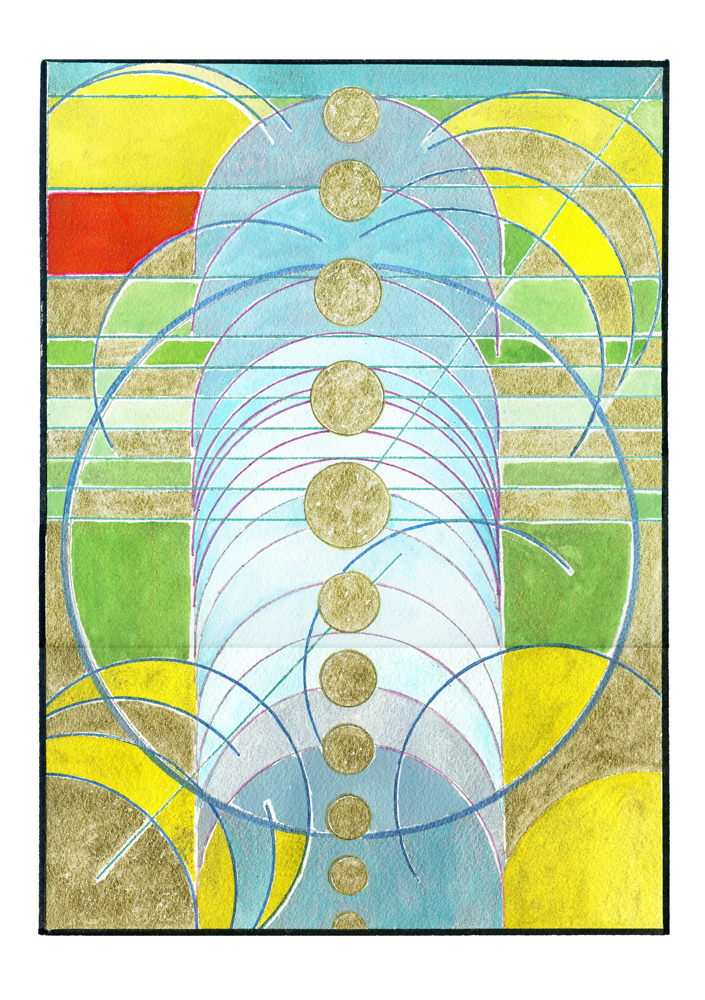
Aquarel Greg Suffanti
Greg: “Migrant Harmony of Dreams – World Citizenship IV is my idea about a utopian future in which all humans are regarded as one, free to live and pursue opportunities anywhere on our planet. I’ve put one large circle in the composition, representing the earth. Smaller spheres rise from the bottom of the composition, through the center of the ‘earth’ to the top of the composition… The heavens. From the Buddhist perspective, the mind travels from life to life in a process called rebirth. Here, the upward flow of the spheres suggests the continuous, unbroken flow of life. The red block in the upper left represents the sun. Green, the bounties of earth and yellow and gold are the heavens, which surround us on all sides. The idea is that a world free of the constraints of citizenship based on countries, but rather, one based on the reality that we all are part of the same world, would provide all humans the chance to move from one happy rebirth to the next… And to enjoy the many fruits of our diverse world in each of those happy lives!”
Sankofa perspectief: tragiek en verhalen van hoop!
Robin: “Is the Sankofa bird aware of this knowledge? What kind of Europe is Sankofa showing us? And how does this understanding help us build a helpful perspective?
The poet Ghayat Almhadoun shows us the connection between the deepest suffering and the deepest sense of belonging. He is neither blaming nor excluding and sees events from both suffering and joy and love. Another of his poems is Ode to Sadness, about Europe. I am sorry if this is a bit much.”
Greg: “You write with great sensitivity and awareness and seem greatly aware of what you seen to perceive as your weaknesses or shortcomings… However, from my perspective, that you are aware of a disconnect within yourself already shows me that the connection is already there and waiting. Maybe just for the right time?
Yes, what would your journey look like? You have an artist’s soul and so that seems like a good place to start. Maybe that’s part of the key to unlocking this whole idea of Wereldburgerschap?
How to create a new language based on your own understanding of limits within yourself and respecting them, and that process leading to opening your heart to the suffering of others. Wanting to help them. I feel like with my migrant series I’m trying to give a face to a faceless group. To show they are not invisible… That someone is thinking of them/you. This makes me feel like I’m a small part of a solution. You mentioned looking at these things makes you want to cry….
Well, maybe that’s what you should do? I spent my early years in Holland crying. I had periods where I fell asleep crying and woke up crying. But I was crying for myself. Somehow, I think we can’t truly move forward unless we move past our own pain. In my case this has taken decades. Be gentle with yourself and respect your boundaries is the only advice I could ever offer.
Such interesting comments Robin…. Why don’t you make an image of this journey? Perhaps seeing limitations within yourself is the key to understanding the limits of others? And the possibilities of going beyond them.
You write beautifully in English…. Dutch is OK too if you prefer. Very polite of you and very typically Dutch in a charming way. Thank you so much for your thoughts Robin… They are very rich and show an artistic sensitivity that I hope you can give voice to!”
Heidi: “Zo diep tragisch hoe de dichter Ghayath Almadhoun ‘l’histoire se répète’ beschrijft: het wegkijken van regeringleiders, van de media, van de bevolking…. En andersom — waaruit hoop te putten valt, zodra wij moedige leiders krijgen, die aandacht durven te vragen voor onrecht, zodat de grond vruchtbaar wordt voor protest en opstand…
Het diepe innerlijke ongemak waarmee hij ons/mij confronteert: mogen we wel blij zijn en genieten van het leven hier in het vrije rijke Europa, terwijl de wereld in brand staat? Mogen we in ons project “Wereldburgerschap van de straat” wel ruimte geven aan de positieve en scheppende kracht van samenzijn naar het goede leven (het spiraliseren en crealiseren)? Mogen we de schoonheid en wijsheid verzamelen die in ons zit en die in alle uithoeken van de wereld door dichters, wijzen en filosofen in wijsheidstradities gemaakt zijn als Quest for wisdom foundation om door te geven in kunstzinnige vormen en het goede en schone in de wereld te versterken….?
Ja, Juist in naam van de menselijkheid die op het spel staat!
Ghayath Almadhoun noemt zich een lafaard, zijn wij dat allemaal? En tegelijkertijd…en juist in het onderkennen van die tragiek dat wij allen in zekere zin omstanders zijn die niets doen… ingezogen in de dynamiek van ‘Wir haben es nicht gewusst’ … ja, daarom juist hebben wij vanwege de immer werkende dehumaniserende systemen aandacht te vragen voor de menselijkheid die op het spel staat!
Want alleen zo kan er ook ruimte ontstaan, naast de verhalen en beelden van verscheurende menselijke tragiek, voor dieper begrip en de noodzaak ook de verhalen van hoop met elkaar te blijven delen en de gedeelde wijsheid en schoonheid door te geven.
Juist in naam van de menselijkheid die op het spel staat! Dank Robin voor je diepdoorvoelde overwegingen en het delen van de links om wat wij met ons project “Wereldburgerschap van de straat” beogen, ook te plaatsen in de straten waar de nood het hoogst is …”
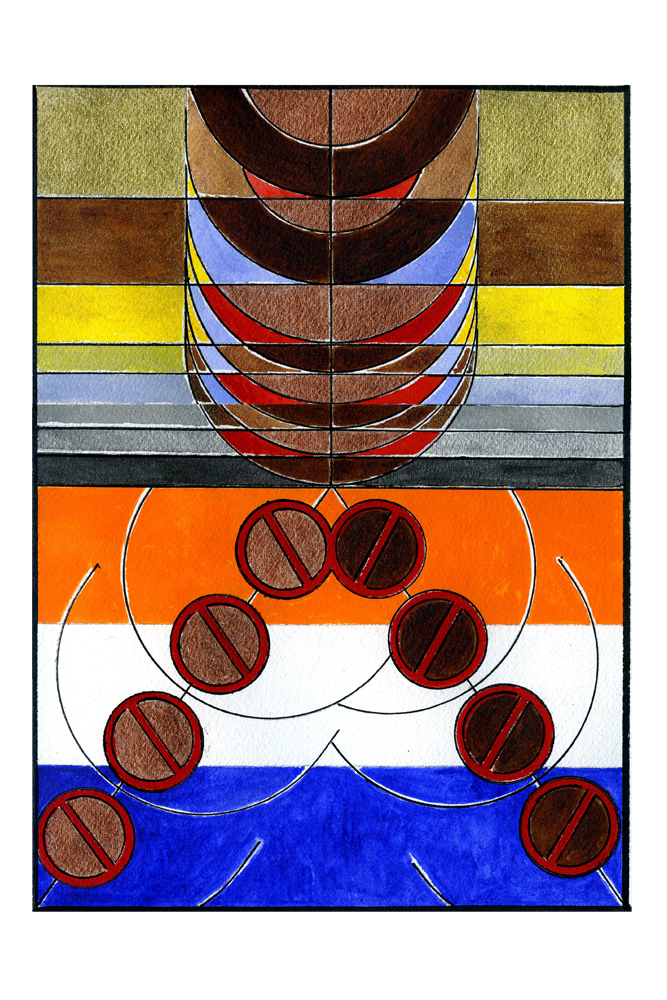
Aquarel Greg Suffanti
Greg: “(Niet) Welkom in Nederland – Migrants Need Not Apply IX is my commentary on the current situation in Nederland, Home of the International Criminal Court and the International Court of Justice. Millions of tourists flock to the Netherlands, which bills itself as the beacon of justice and freedom. Maybe just not for Migrants?
Britain wants to ship its migrants to Rwanda. Holland doesn’t want them at all. This aquarelle reflects Geert Wilders’ plan to declare an emergency in which migrants would be banned for two years from coming to the Netherlands. A preposterous idea given the entire history of the world is one giant migration story. The ‘migrants need not apply’ portion of the title reflects a late 19th, early 20th century American (racist) phenomenon in which businesses posted job offerings with the added message that ‘Irish need not apply’.
We begin our migration journey at the top center of the composition. Here, brown and copper spheres descend downward toward a giant Dutch flag. These represent the migrants. The blue in the spheres is their hope, the red, their hearts. To the left and right of the spheres are bars of color that go from gold, brown and yellow, which are the riches of their former countries (not to mention sunny skies), to greys and black: (Not) Welcome to the Netherlands. The Dutch flag has two diagonal rows of “Not Welcome/Keep Out” symbols, whose centers are either brown or copper: Migrants. The two diagonal rows and the top column of spheres form a Peace sign: My comment on the irony and hypocritical nature of the actual situation. The spheres of migrants spread out, going around the keep out symbols, as migrants always do, finding a way around the current system. It’s impossible to stop the movement of people. Furthermore, enacting policies that will further stigmatize and isolate whole groups is nothing other than racism in action and deed.”
Heidi: “Greg, je bent tot op de bodem van de tragiek gegaan met het ongemak en hebt negatieve gevoelens herkauwd en brengt de harsh policies towards migrants confronterend in beeld. Hoe bijzonder dat je de serie een vervolg geeft met de kant van menselijkheid: hoe je de migranten een gezicht en stem gaat geven aan hun levensgeschiedenis!”
Migranten een gezicht geven…
Sergio uit Brazilië
Greg: “Sergio’s Amsterdam Harmony of Dreams V is the story of my friend’s 10 year stay in Amsterdam. Sergio came from the jungles of Brazil near Sao Paolo, where he eventually lived and worked as an architect until he was diagnosed with HIV. He came to Amsterdam around the beginning of the century and wanted to pursue his dream of living here. He ended up living completely outside of the system, staying illegally and working as a house cleaner and stock person in a small grocery store in Amstelveen. His illegally rented apartment was expensive and ate up most of his money. He often felt sick from lack of medicine and life was very hard. And depressing. He finally decided to go back to Brazil, now a middle aged man.
I met Sergio around 2008. I tried to help him in various ways, including sponsoring a show of his paintings at a gallery in Amsterdam in 2010. Also in 2010, Sergio fulfilled another of his dreams by performing in flamboyant Brazil drag on a boat at the Amsterdam Gay Pride canal parade. His exuberance was captured in a photo, which ended up being the cover for a hardcover book about the canal parade. Sergio existed! In Amsterdam! He was thrilled. Sergio left Amsterdam late in 2010, a happy, confident individual, happy to return to Brazil as a reborn man!
This aquarelle shows Sergio’s journey. We begin in the bottom left with blocks of traditional Brazilian colors. Above that, angled bars lead us to Amsterdam. I wanted to suggest movement through the upward movement of the spheres. The top left is brown. This is the cocoon, the womb from which Sergio will be reborn. It was filled with years of intense fear and loneliness. And eventually hope. The spheres turn into a golden cosmic egg, which fills the upper right side of the composition. Spheres continue to descend downward. From this Sergio returns happily to Brazil after 10 years, a very different person. This is a story with a happy ending!”
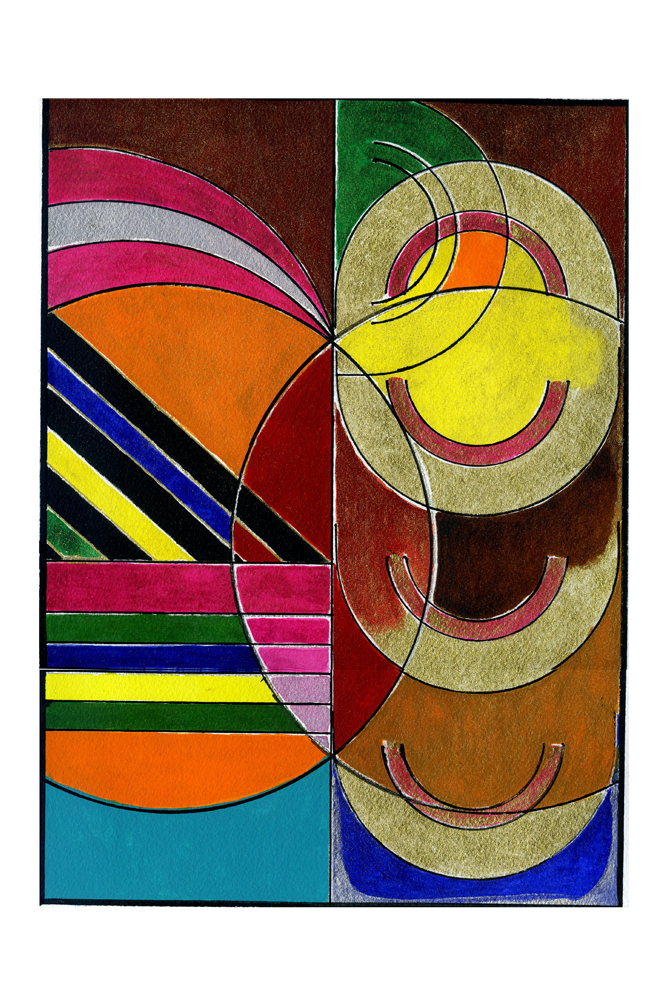
Aquarel Greg Suffanti
Geshe Sonam uit Tibet
Greg: “Geshe Sonam’s Harmony of Dreams VI is the story of my (Buddhist) teacher’s life up until now. Sonam Ngodrup was born in 1968, in Kham, Tibet. At 13 he escaped to India and went to live with his uncle, Khen Rinpoche Geshe Delek, who was the abbot of Sera Monastery. Sonam was ordained, eventually earning a Geshe degree, which is a 25 year study program. He graduated at the top of his class and became a popular teacher at Sera. In 2012 he was invited (along with his translator, Canadian born Ven. Khedrup) to become the resident teacher at Maitreya Institute in the Netherlands. Geshe la struggled with health issues exacerbated by the cool and wet Dutch climate. Maitreya Institute suffered with enormous legal bills as a series of lawyers tried in vain to get a visa for Geshe la in order to stay in the Netherlands. The story has a happy ending, as Geshe la and Khedrup moved to Canada in 2017. Geshe la will soon become a Canadian citizen, after being essentially stateless, because Tibetans are not granted citizenship, only residency. He and Khedrup are planning on returning to Holland in August ‘24 and Geshe la gives regular lessons to his Dutch students via Zoom.
Once again, our story begins in the lower left corner. The green bar represents Tibet. Above, gold and saffron bars alternate. These are the colors of ordained Tibetan Buddhists. This is Geshe la’s journey to India and his being ordained. Above, gold and saffron spheres move upward. With the added blue, we have the colors of the Tibetan flag. This is Geshe la’s stay in the Netherlands. (Note the grey bar) He is a Tibetan Lama, an intellectual who teaches and explains the words of the Buddha. Thus, the gold above the spheres, representing the preciousness and rarity of these kinds of beings. The blue bar on the upper right is their move to Canada. Geshe la is a monk and a teacher…. This is his earthly identity. It doesn’t matter where he lives, because internally, he is always at home no matter where he lives. That being said, he will finally be free to travel and teach once he finally becomes an actual citizen of Canada, and not a Tibetan with refugee status in India!”
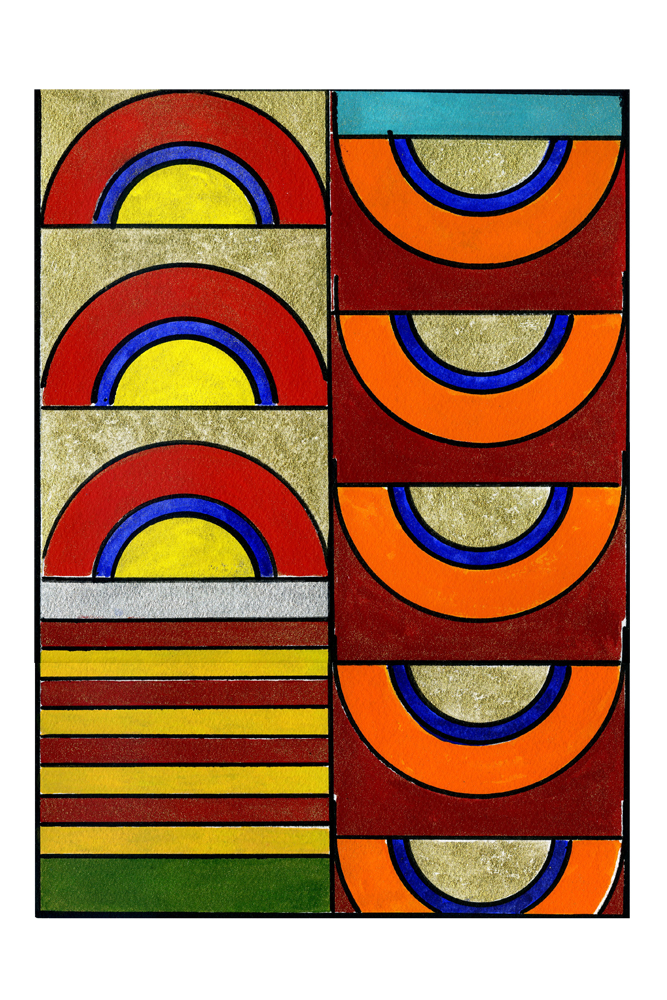
Aquarel Greg Suffanti
Remy uit Nigeria
Greg: “Remy Wins the Lottery! X is the tenth and final aquarelle about migration/migrants. My partner, Robin, first met Remy in 2016 at an HIV /AIDS conference in the Netherlands, where he was working in outreach programs. Remy comes from Nigeria and is HIV positive. Since the introduction of new, highly effective HIV drugs in 2010, having HIV is no longer a valid reason to declare asylum in the Netherlands, as these drugs are widely available. That being said, in 2021 in Nigeria, there were 51,000 HIV related deaths, including both adults and children. The largest group, at 17,000, were women. But Remy was more than HIV positive… He was a convicted felon, a criminal, and he had been imprisoned for his crimes. His crime? He was living as an openly gay man. Africa in the 21st century! However, because he’d been jailed for being gay, he was successfully able to declare asylum and now happily lives and works in Brabant. I’ve met Remy a couple of times when he came to the Hague to stay in Robin’s house while we went on vacation. He absolutely loved going to the beach, and I’m sure people were fascinated seeing this incredibly dark, incredibly fit and handsome man sunning himself on the beach! He loves his new life and is now a Dutch citizen. So, Remy did indeed win the lottery, going from a prison cell to a beautiful and happy new life! I could have just as easily called the aquarelle Remy’s Rebirth!
We enter the painting from the bottom. Here, the green and white of the Nigerian flag fill the space. In the white center is a red ribbon, the symbol for HIV/AIDS, representing the more than 40 million people who have died so far from this disease. Above the flag, on the left and right, brown, gold, silver and copper spheres rise upwards. This is Remy in 2016, on his way to a conference in the Netherlands. Little did he know then that he’d not be returning to Nigeria. The red spheres in the center, also rising, represent Remy’s heart and soul. From the top of the composition, gold disks descend toward a cosmic egg. The heavens in motion. The center of the egg is filled with the rainbow colors of the gay flag, a symbol of freedom and hope. Note that in the center, Remy’s heart and soul also form an egg shape, symbolizing his coming into cosmic balance here in the Netherlands.”
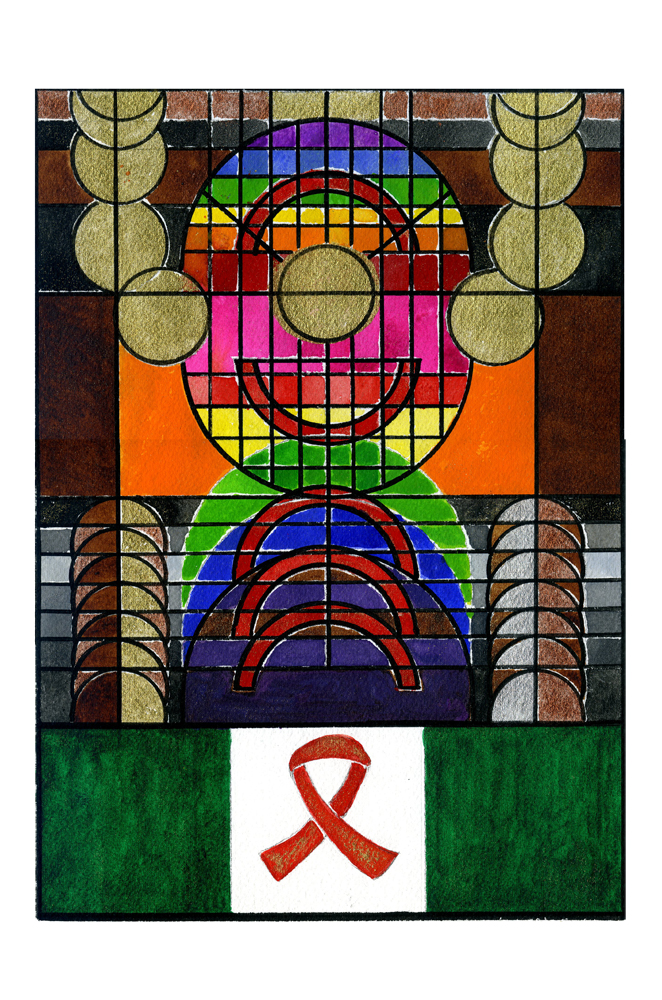
Aquarel Greg Suffanti
Zijn wij allen migranten….nomaden?
Robin: “Hereby my first try of an aquarelle of my tiny migration story mostly in Netherlands from below all the way up.
First starting in Norway, Trondheim until 6 years old. Growing up, often alone in nature. Woods, wideness, snow, skiing.
Hazerswoude in between Leiden en Alphen a/d Rijn until 13 years old. Difficult to integrate without understanding fellow schoolmates in elementary school. Working on a farm, rowing a small rubber boat on the big river. Growing up with two dogs.
Nijmegen until 22 years old. Secondary school; discovering social life, green scenery, trees, woods, interest in spiritual life; pax christi, Taize, zen, sufi’s, tidorp, osho.
Living in a squad house with many people. Starting to make art, having a dog, starting a bakery.
Next stop Amsterdam until 24 years old. Living on a houseboat, working as a carpenter, working as a cook, starting Gestalt therapy, renting a studio; starting to make artwork on Gestalt base.
Groningen lay-ordination Baker Roshi in Germany, until now Art-academy & art therapy, Begeleidingskunde, starting to work in health care, working as an artist and art therapist. Three month practise period in Colorado. Getting married, starting a family, getting a daughter.
Made my egg grow until who I am now, with cracks.”
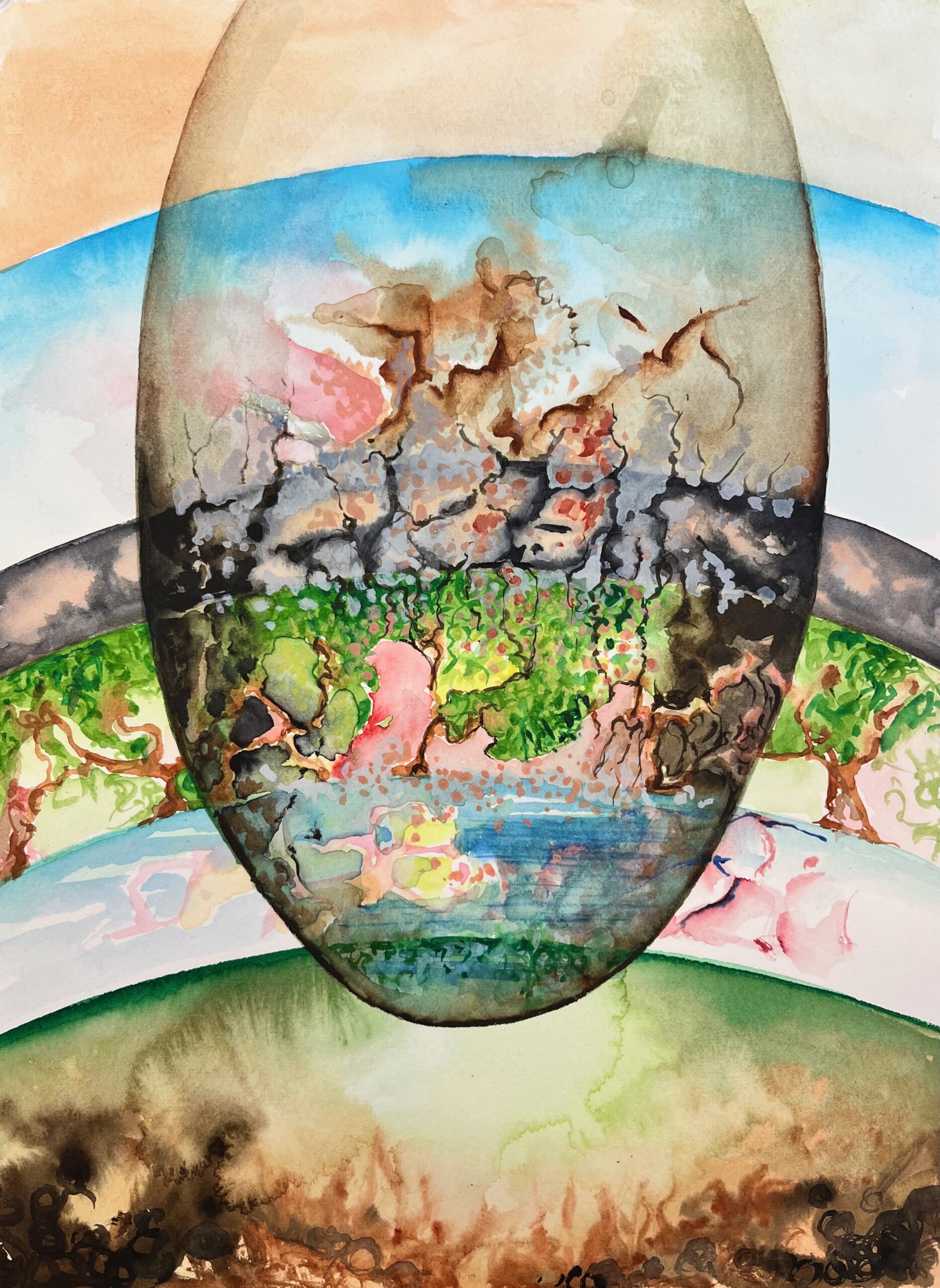
Aquarel Robin Stemerding
Heidi: “Robin, je levensgeschiedenis vind ik prachtig indrukwekkend in grote stappen met karakteristiek gekleurde levenskeuzes naar jou als kosmisch ei met een crack….maar je weet wat ze zeggen/ Leonard Cohen bezingt over de cracks where the light gets in….!”
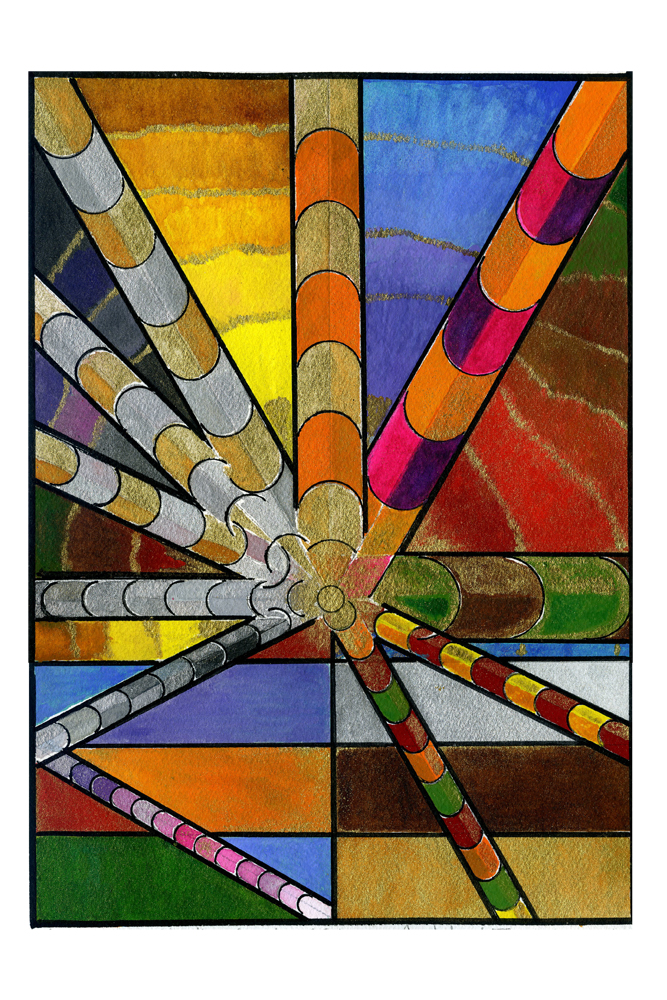
Aquarel Greg Suffanti
Greg: “Me, myself and I – And 25 years in Amsterdam VII is a continuation of my series on (IM)Migrants and is a visual representation of my life up until now. So, it’s not just 25 years… I only realized afterwards that I was looking at my entire 60 year life. For my self portrait, Me, Myself and I, I thought about the Dutch expression that “je moet in de molen komen”. Literally translated, “you have to get inside the windmill”. In reality, I had no job and thus no legal right to stay in the Netherlands. I needed to find an employer that could prove no one in the European Union could fill the job I wanted. If I could, then I could get into the “windmill” of bureaucratic processes that would give me permission to stay in the Netherlands and provide me an income. In other words, getting inside the windmill meant everything, and thus my windmill composition. Or, my version of me as a windmill.
I leave it to you to decide if I’m a real (im)migrant or not? I grew up going to a private swim and tennis club, private schools, and earning a BA from Yale in 1987. In 1996 I was diagnosed with advanced HIV. Not only was I sick, I became addicted to the painkiller Oxycodone. My world crashed in. My then partner, now with full blown AIDS falls in love with someone else. I work as the director of the Seattle operation for a company that is now public. They want me to open their new operation in Charlotte, North Carolina. Told to expect a short life, I ran away to Amsterdam in March of 2000. I had no job and no place to live, and I was sick. I was given an apartment in a condemned building after I was kicked out of the apartment that was being illegally rented to me…. Which I didn’t know. My new place was a room with no shower. Rats ran up and down the ivy which grew all over the interior courtyard. My three cats, which I’d brought from America, kept me safe and comfortable. I hid my illness out of fear of being kicked out of Holland. I eventually found a job via the Buddhist center where I volunteered and studied. I worked for 13 years as a caregiver to handicapped and terminally ill people. I stopped in 2014 after suffering a stroke. I eventually got medicine that worked (2010), became a Dutch citizen (2008), got an apartment in my own name (2016), a partner (2018) and continue to volunteer and study at Maitreya Institute. I only realized afterwards that I was looking at my entire 60 year life.
As in the three previous aquarelles, the story begins in the lower left corner: Here, a slender spherical column ascends towards another, predominantly grey column. This is my life moving forward to my move to Amsterdam. The following four columns are grey, with gold bands: Although I had many challenges, I never gave up (gold) hope. The central column is orange and gold: I moved into my current house in 2005, and it would take eleven years before I fought my way to have the rent controlled apartment in my own name in 2016. I was finally home, because I had a place to call my own. This idea of home is central to my life in my adopted country, probably because I was adopted, and I know that you can love with all your heart, that which maybe is not directly connected to you. Anyway, the next column is orange and pink/purple…. It is 2008 and I am a Dutch citizen, having had to renounce my American citizenship. The next columns are about my current life…. The gold and saffron from my Buddhist world, and the final column, with orange and green: My thriving, green life in Holland (orange)… My happy ending with good health and a loving partner. The three bars in the bottom right, of silver, brown and gold, represent this fortunate, grounded result of the last 25 years!”
Robin: “I discover 3 more aquarelles that I did not see before. The stories of Sergio, Geshe Sonam and you, Greg. The impressive stories of 3 (im)migrants struggling to make a living, searching a place, travelling, experiencing, searching asylum, or being stateless, dealing with health and sickness driven by a wish to live life a certain way. A mixture of difficulties, but also being pulled by something, by longing, by something unknown and unfamiliar or something clear and familiar. From a familiar place and experience to being reborn by different experiences. I am still working on my story that is about migrating from one world into another mostly in the same country, having different experiences until the moment of now.
In the background is Sankofa, looking back- and forwards, there is wave as a free experience amongst fellow travellers, there is a golden Egg, which can be under pressure and crack and there can be exchange towards outer worlds that can be associated with learning or tasks.”
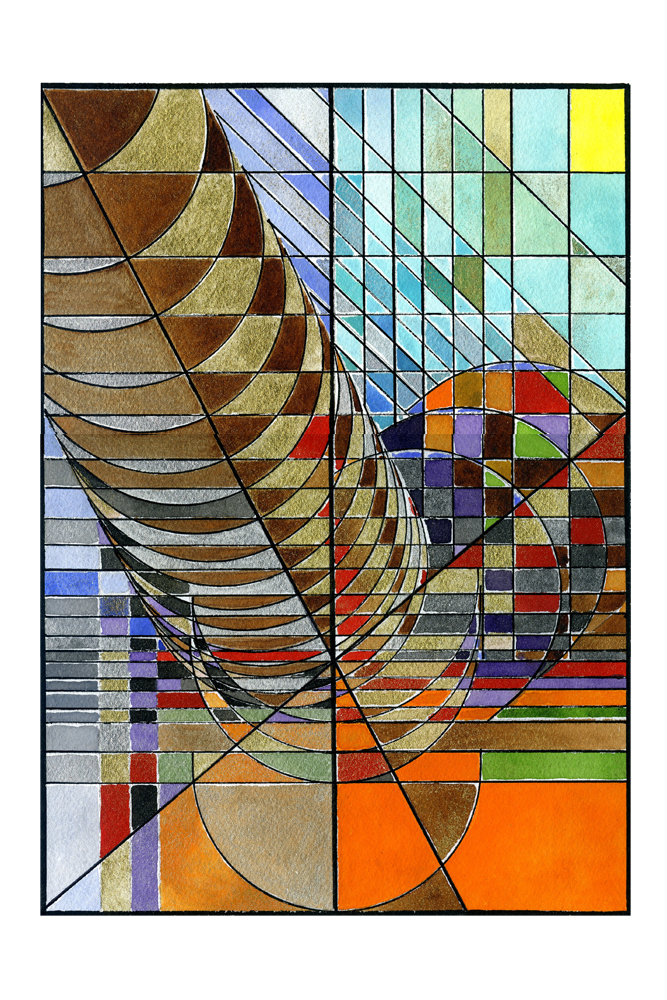
Aquarel Greg Suffanti
Greg: “Uitgeprocedeerde Asielzoekers – Broken Promises VIII illustrates my experience volunteering for 5 months at a center in Amsterdam that works with migrants who have been ‘processed out’ of the Dutch immigration system. In other words, they have been asked to leave the Netherlands, permanently. Covid arrived in 2019, and so I stopped working at the reception desk. The people I met were exclusively young men, mostly from Africa and by and large had been living in Amsterdam for around five years. They were all polite and all very quiet. My job was to offer coffee and tea while they waited for their appointments with their case workers. There was almost a funereal air that hung in the waiting room. This was and is not a joyful place. The quietness tells the story of broken dreams. The system is designed this way.
I titled the aquarelle Broken Promises, as a critique of this (European /Dutch) process, which not only destroys dreams, but breaks the promise of basic humanity: to care for one another and to offer refuge to those in need. The story begins in the upper left corner. Migrants, shown as half spheres, descend downward. I primarily used shades of brown for the simple fact that these migrants are brown. The right side of the spheres are warmer in color than the left… There are primarily two kinds of migrants: The ones who go through the system, and those who don’t.
I once helped a young man with ALS. His housekeeper, named Flora, was one such person. She came from Nigeria via Belgium. In the few years that I worked there she was picked up multiple times and returned to Belgium, as the system dictates. She then immediately boarded a bus and returned to her life in Amsterdam. The spheres move downward, crashing in Holland. I thought of a glass breaking, with shards going in all directions. Of course, the shards are in actuality real human beings. The bottom right corner is the realization of the dream: A happy, legal home as a future Dutch citizen. The rectangle contains a fertile patch of green, lots of orange, the color of the Netherlands, and a couple of shards, representing the very few who will successfully go through the system. The majority of the migrants are pushed away, the shards spraying upwards to the right, towards the sky and an unknown future, having spent years of their lives hoping in vain for a different outcome. Sitting and waiting, not permitted to work. A kind of punishment for young men full of energy and hope. The lower left are those who live outside of the system, like Flora and Sergio #6. I used a grey palette to indicate the ‘grey’ area in which these people live. However, they are also the quarter circle of gold, indicating their intrinsic value as humans. And there’s orange too!
These people may live here illegally in the eyes of the law, however, like Flora and Sergio… This is their home and they love their country, whether that love is reciprocal… Or not!”
Robin: “And then I see again a new aquarelle: ‘uitgeprocedeerde asielzoekers’. Thanks for sharing Greg! It makes a connection with my work in a forensic clinic.
Looking back at my first try; it brought me to a place from experience. I did not tell my usual story with repeating words and known meanings, I ended up in a place where I had no words and I could start asking questions. Your comments and reactions helped me to turn a mirror and open a space.
As I think about an armour for global citizens, it would include the interest and the invitation to express. It would include the openness and willingness to share experiences. It would include the surprise of shared inside investigation. It would express caution for confrontation and judging from a harsh outside viewpoint. It would express space in which things can appear. It would secure save space and time.”
Greg: “Interesting comment Robin, or rather intriguing question: Dichterbij of verder van huis? Well, considering you’re digging up all these elements from your own life, maybe you feel like I do?: A bit unsettled and very happy this series (which I love) is ending….. With this email and aquarelle #10. I’ve felt churned up, and actually am emotionally exhausted and definitely don’t want to do more…. So, I withdraw my question about doing more based on your work. However, I feel a glimmer of hope returning as I feel I now have a bigger, better, more clear idea of my own life, my ability to grow, but also my limitations. And also how shifting my own attitudes and thinking about these topics shows me how fragile progress is. I had a nasty burnout in 2010 after realizing that I had compassion and love for others but not myself. I’ve had a saying on my refrigerator ever since… “Do more of what makes you happy”.
It makes me think of my Hannah Arendt Amor Mundi watercolor…. I love how she asserts the need to accept and love yourself fully, warts and all, before you can love the world. Nobody said it’s easy. I’m still trying! I’m always left thinking… The purpose of life is to grow and to try to help others. Ultimately, I feel like my art is a way of fulfilling this obligation to myself so that I can die with a peaceful mind. I’m also reminded of my Buddhist teacher Kaye Miner, who drummed into me the necessity of taking baby steps. So, more self – acceptance and less self – criticism. She also once said, “When I look at myself, I think, ‘it’s not so great’. However, when I look at others, I think ‘it’s not so bad’. Anyway, I’m trying to put a positive spin on this because I need to put this series behind me.”
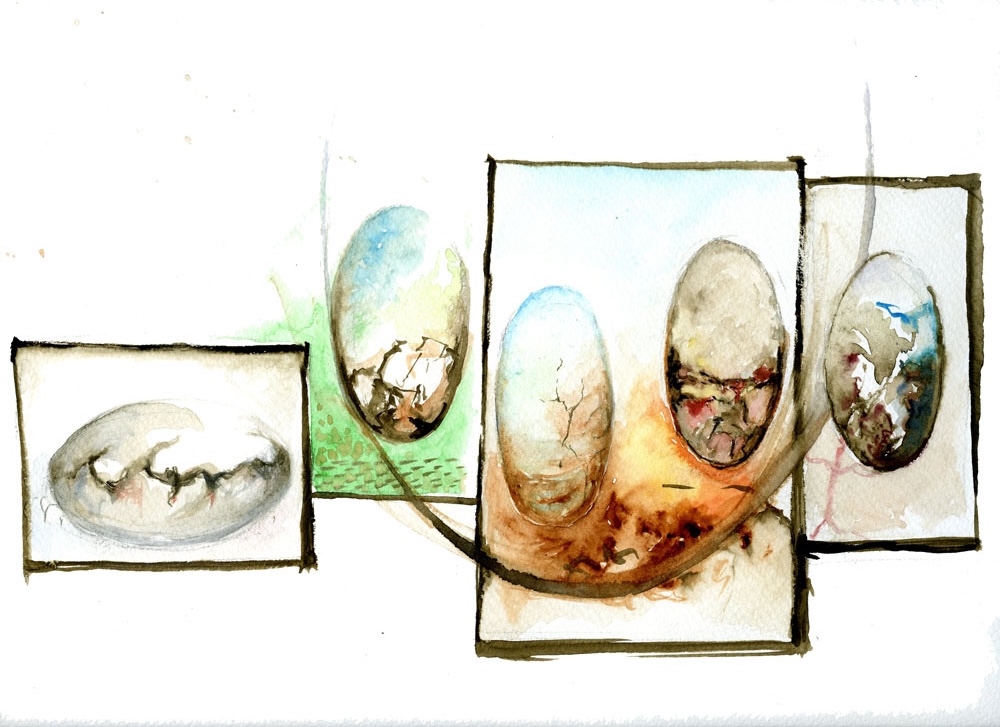
Aquarel Robin Stemerding
Robin: “Heidi’s question about my work as an art therapist in a forensic clinic and how ‘world-dreams of migrants’ are met brings up questions about how to approach this. Is it about what exactly is happening? Is it about what I meet in my work? Is it about how I meet with patients in my work?
In a forensic clinic patients are imprisoned for unknown time and treatment like therapy is not optional but obliged. Each 2 years a court gathers to decide if and how further treatment is necessary. Most of the patients have documents and can start resocializing but we have a group of ‘ongewenst vreemdelingen’, patients in a procedure with IND to be sent back to a country of origin even if they sometimes did not grow up in this country.
I made a next try for an aquarelle working as an art-therapist in a forensic clinic. ‘For those who belong and do not’. Working and making contact despite huge insecurity about the nearby future. Some will be allowed to resocialize, others will be sent back. A decision with big impact. We try to prepare, a social worker will visit hospitals and family if there is family. Sometimes this means a free future, without being imprisoned anymore, finding work and being with (part of the) family. Sometimes this is worrisome if the country of destination is in war but sometimes lawyers make a successful protest successfully and a patient is allowed to stay and re-socialize.
I did paint myself at work with patients in different situations, going out and preparing for resocialization, being in therapy or being ‘ongewenst’ and in great insecurity, or not being in contact at all.”
Heidi: “Heb zeer veel waardering voor het werk dat jullie beiden doen, jullie verhalen en het in beeld brengen van een essentie, van wat het vraagt om te werken met mensen, die in de wereldsamenleving gemarginaliseerd zijn – vluchtelingen, migranten, patiënten, criminelen, gedetineerden, ongedocumenteerden, uitgeprocedeerden…. ontheemden….hoe we deze mensen aan de rafelranden van onze samenleving ook noemen, het zegt vooral veel over onze eigen blik op hen!
Ook ik, met alle documenten in handen, een huis en weliswaar niet alle 7 vinkjes — uit Joris Luyendijks boek, waar we het zaterdag met Klaske in ons gesprek over Amor Mundi, het documentatieboek rond ons project “Wereldburgerschap van de straat” over hadden — en in de gelegenheid om zinvolle bijdragen te mogen geven in verschillende kringen, voel me desondanks ontheemd in deze wereld… Voor mij betekent dit dat wereldburgerschap ten diepste het zien van de ander als mens inhoudt. Dat betekent wederkerigheid en het eerlijk gedeelde welzijn en geluk als samenleving, waar je dan ook woont in deze wereld. Zodat het leven in gemeenschap een echt thuis geeft als mensheid ..… Dat we daarvoor de wijsheid uit alle windstreken voor nodig hebben, vormt uiteindelijk mijn motivatie voor het verspreiden van de QFWF-vonkjes om met elkaar de interculturele gemeenschap voor te leven, die we graag in de wereld willen zien. En zo een kosmopolitisch vuur aan te jagen!
Ben zeer onder de indruk Greg, by your “Uitgeprocedeerde Asielzoekers – Broken Promises VIII”! Especially what you write as essence, that our migration system “…breaks the promise of basic humanity: to care for one another and to offer refuge to those in need.”
It is so worthwhile to give this shadow world attention on the one hand, to make it visible what is happening behind the screens, showing the inhuman consequences of the system of what is, at least from the outside, a free and democratic country. And on the other hand, to give the people who are in the grey area with broken world dreams the colours of humanity…to honour their lives and intentions and giving them a face that is taken away by an anonymous inhumane system!
Honouring the people who got struck in the system en retell their story’s, thereby showing them respect and their menselijk gezicht achter ‘clinical words like ongedocumenteerden’!
Hoe mooi als we hier een tentoonstelling over kunnen organiseren…”
Greg: “Interesting idea about a tentoonstelling; I was thinking the same thing as I decided to make 10 total and thought, “maybe some place like the Weesp library?” At any rate, I think together they make a powerful statement, and, along with the comments, an interesting and important contribution to changing our attitudes and learning to see actual faces, human beings, rather than just a faceless people with dark skin and no real identity.
Which brings me to the final aquarelle in the series, Remy Wins the Lottery X!. I love a happy ending. Growing up meant Sunday evenings spent watching “Walt Disney Presents”, with Mr. Disney presenting an endless series of happy ending programs. This has had a profound impact on my view of myself and life, and still does.”
Robin: “Thanks Greg for your reflection on the (im)migrant series. Thanks for your big effort to capture your life and lives of many others in pictures. I do read between the lines that it brings you something. Not sure what exactly?
Yes, my comment about ‘dichterbij of verder van huis’ was about an unsettled feeling, slightly out of comfort and not in control. It feels like taking risks. This free associating, this not controlling all of it. Working like this brings me to making artwork where I don’t have a feeling of accomplishment. It feels like an open ending, I can’t make conclusions and this feels vulnerable. And it also feels like an open space where other questions could be asked which could be a positive step in a process. And also I didn’t frame it in either good or bad or did not direct towards a positive discovery or uplifting intention.
The picture of my work in the forensic clinic resonates a harsh reality and could be a confrontation with a very depressed situation. Often it is, as I feel my picture reflects. It brings up the question why I keep on working here and why I do not choose something more light or uplifting? Instead I developed working in a way to stay more resilient. For instance the experience we make in our exchange in pictures, the openness and the way of touching upon themes and working with them from an inside out way, gives me hope, as does working in art. I notice my courage grew, daring to work for instance with men with high risk of physical aggression. I dare to overcome my fear (without being unrealistic) in making contact using art to bridge.
Art helps me orientate and relate more than language does. Having a conversation and directly drawing themes is what I do and this often makes a different conversation than just talking. We are more able to address underlying themes by which the patient feels understood than the usual language for treatment.
I understand your withdrawal from wanting to give shape and colour to the stories I could tell you. Also I am not allowed to bring these stories just like that into the open. It is okay as long as it is my story and nobody else could be recognized.
Your bringing up considering limitations feels very healthy and important. Taking care as far as feels comfortable and not going over our own limits.
The Buddhist perspective of working for the benefit of all sentient beings is really helpful there, where I also have to include myself as a sentient being too.
I do recognize another theme though; the windmills or in the worst case a treadmill of institution(s). Or how to stay humane with all the protocols and organized care. I feel it is my big striving to fight for a humane relating and behaving in an organized institution like this.
Dear both, have a good day, and thanks for this wonderful exchange!”
Heidi: “Dank voor jullie afrondende reflecties over deze bijzonder intensieve en zo boeiende ontdekkingstocht samen, vanuit het spiraliseren, en crealiseren rond het Kosmisch Ei via de ontmenselijkende migranten politiek naar het geven van een gezicht aan migranten en het stem helpen geven aan onze én hun werelddromen.
Robin, mooi wat je schrijft over het waardevolle van het met elkaar delen hoe we staan in deze thema’s rond wereldburgerschap: dat onderstreep ik van ganser harte! Vooral om dat niet alleen met feiten en cijfers, maar juist ook met kennis van binnenuit te doen. Het betekenisvolle van de verbeelding en het (be)tekenen van het broze en kwetsbare in de ruimte tussen mensen: dat herken ik als jouw kwaliteit hoe je in onze bijeenkomsten steeds je zorgvuldige reflecties op het woordeloos voelbare, al tastend in sprekende beelden en woordenvindend aan ons teruggeeft!
Hoe je zowel zelf je leven als migrant met ons deelt, Greg, als met het eren van de mensen die hebben geleden aan de ontmenselijking, werk je aan een omkering en humanisering ervan: door in je beelden en woorden terug te geven wat hen door de ‘bureaucratische molen’ is ontnomen! Dit beeld van de pijnlijke bureaucratische realiteit, waaraan wij enerzijds allen medeplichtig zijn, vind ik ook daarom zo waardevol, dat het anderzijds mensen ‘ontschuldigt’, die hierin werkzaam zijn: uit even menselijke motieven ‘to make a living’ en een gelukkig leven te leiden. Bewustwording van de ‘schuldige patronen’, de institutionele onrechtvaardigheid in de samenleving en organisatie systemen om die te beantwoorden met menselijkheid in kunstzinnige vormen: dat is in mijn ogen een grote waarde van de ontstane collecties vanuit onze QFWF-missie en filosofie.
Jouw opmerking over je Walt Disney Sunday avond, Greg, en het ‘happy ending gevoel’ inspireert me (juist met het overweldigende negatieve in de wereld/op het wereldnieuws) met elkaar verder te werken aan “Wereldburgerschap van de straat” en er de positieve draai aan te geven, die jullie gecreëerde kunstvormen uitstralen: veel dank!!!”
